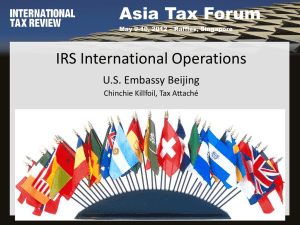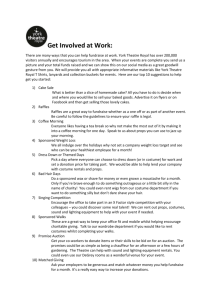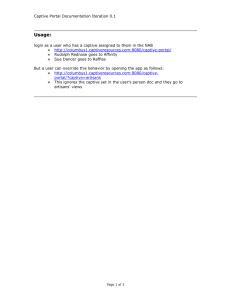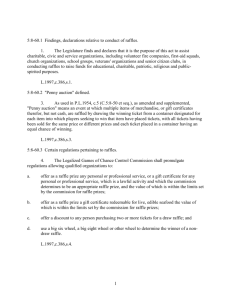1 SIR STAMFORD RAFFLES - A MANUFACTURED HERO?1 Nadia
advertisement
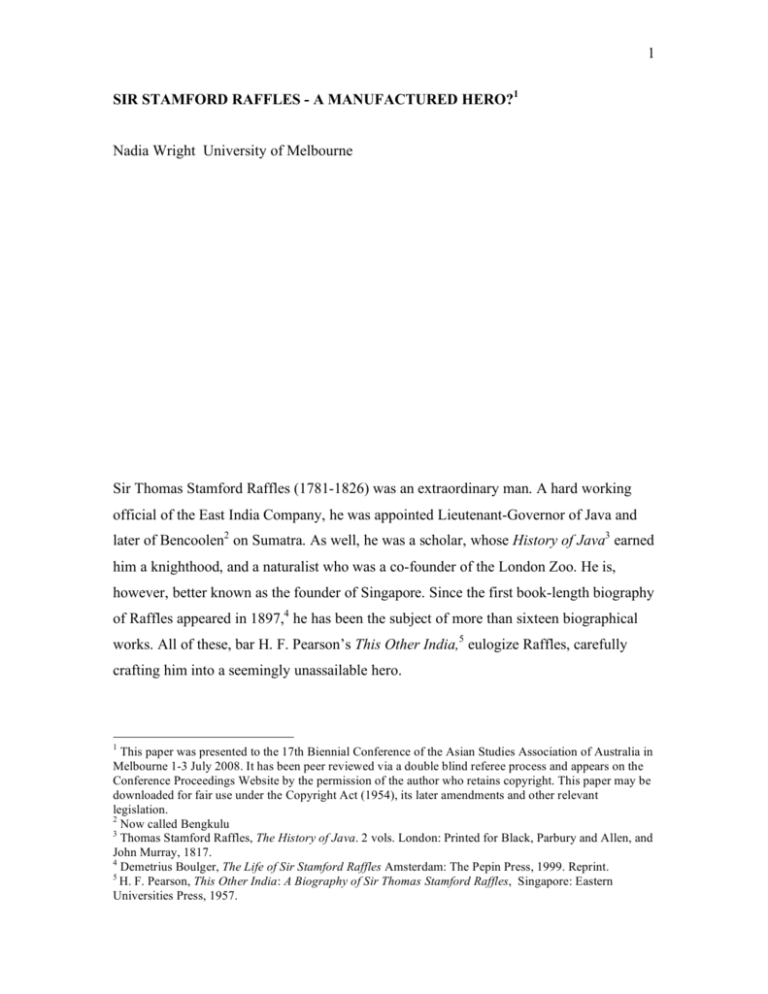
1 SIR STAMFORD RAFFLES - A MANUFACTURED HERO?1 Nadia Wright University of Melbourne Sir Thomas Stamford Raffles (1781-1826) was an extraordinary man. A hard working official of the East India Company, he was appointed Lieutenant-Governor of Java and later of Bencoolen2 on Sumatra. As well, he was a scholar, whose History of Java3 earned him a knighthood, and a naturalist who was a co-founder of the London Zoo. He is, however, better known as the founder of Singapore. Since the first book-length biography of Raffles appeared in 1897,4 he has been the subject of more than sixteen biographical works. All of these, bar H. F. Pearson’s This Other India,5 eulogize Raffles, carefully crafting him into a seemingly unassailable hero. 1 This paper was presented to the 17th Biennial Conference of the Asian Studies Association of Australia in Melbourne 1-3 July 2008. It has been peer reviewed via a double blind referee process and appears on the Conference Proceedings Website by the permission of the author who retains copyright. This paper may be downloaded for fair use under the Copyright Act (1954), its later amendments and other relevant legislation. 2 Now called Bengkulu 3 Thomas Stamford Raffles, The History of Java. 2 vols. London: Printed for Black, Parbury and Allen, and John Murray, 1817. 4 Demetrius Boulger, The Life of Sir Stamford Raffles Amsterdam: The Pepin Press, 1999. Reprint. 5 H. F. Pearson, This Other India: A Biography of Sir Thomas Stamford Raffles, Singapore: Eastern Universities Press, 1957. 2 In the first part of this paper I examine how Raffles has been manufactured into a hero, and in the second consider why, and then the consequences of this valorisation. I suggest that four techniques have been interwoven to construct the image of a hero: a rags to riches story has been invented; some facts have been exaggerated and others minimized, usual happenings have been re-cast as unusual and Raffles has been glorified at the expense of others. The rags to riches approach was an attribute of many Victorian biographies which told the story of a boy from a poor background who rose against all odds to achieve high status. In these stories, the path to success was hard, strewn with obstacles to be overcome. The hero would encounter hostile opponents eager to see him fail, but he would vanquish his enemies. Fate would strike him cruel blows: he would be spurned, but he would remain a hero. To fit into this scenario, Raffles’ middle-class background was down-graded to a penniless one, brought about by a debt-ridden father.6 Without evidence, biographers then described how Raffles was denied a complete education, alleging he had to leave school early and accept a menial job7 to support his impoverished, widowed mother and large family.8 Much of that is romanticized fiction. Raffles’ father was the experienced captain of a West Indiaman regularly sailing on the Jamaica run9 until his unexpected death there in 1797.10 The family rented a ‘genteel substantial dwelling house’,11 at number 10 Camden 6 Maurice Collis, Raffles London, Faber and Faber, 1966. p. 23; R. Coupland, Raffles of Singapore. London, Collins, 1946. p. 6; Emily Hahn, Raffles of Singapore a Biography, New York, Doubleday & Company, 1948. p. 15 7 Boulger, p. 29; Coupland, p. 6; Collis, p. 23 8 Collis, p. 25; Asiapac Comic, Stamford Raffles Founder of Modern Singapore, Singapore: Asiapac, 2006. p. 10; Hahn, p. 15 9 see The Times 1785-1794 at Times Digital Archive 1785-1985 at http://infotrac.galegroup.com.ezproxy.slv.vic.gov.au/itw/infomark/0/1/1/purl=rc6_TTDA?sw_aep=slv accessed 12 January 2008 10 L. V. Oliver, ed., Caribbeana: Being Miscellaneous Papers Relating to the History, Genealogy, Topography, and Antiquities of the British West Indies 6 vols. London: Mitchell, Hughes and Clarke, 19101919. vol 4 p. 270 11 The Times, Saturday, May 10, 1800, p. 4 3 Street, in Islington, North London, indicating the family was enjoying an above average standard of living until at least mid-1800. Furthermore Raffles had left school in 1795, two years before his father’s death. At that time his mother was not penniless, nor a widow; nor was the family large for those times, comprising Raffles and his four sisters. Biographers made much of the fact that Raffles had left school by the age of fourteen. For Raffles to have remained at school until he was nearly fourteen was an exception. Public education had not yet been introduced and middle-class families sent their sons to private schools or ‘grammar schools’ where admission was usually through patronage.12 Raffles attended the well-known Mansion House Boarding School, run by Dr Anderson13 where a number of other famous men were educated. It should be remembered that even in the early 1800s, education remained the preserve of the minority, while in London in the 1820s, a large number of children were working in factories, or were in service, from the age of six.14 Raffles’ first job as an ‘extra clerk’15 at East India House was described as lowly and hence another hurdle to be overcome, but biographers have overlooked the circumstances of acquiring such a post. Fourteen was the common age at which a youth was appointed as a clerk by the East India Company. Clerkships were highly sought after, applicants being accepted only through patronage.16 Raffles was privileged to get one foot in the doorway. 12 Leonore Davidoff and Catherine Hall, Family Fortunes: Men and Women of the English Middle Class 1780-1850, London, Hutchinson, 1987. p. 235 13 Thomas Faulkner, The History and Antiquities of the Parish of Hammersmith Interspersed with Biographical Notes. Nichols and Sons, 1839, p. 262, at http://books.google.com/books?id=EZULAAAAYAAJ&pg=PA261&lpg=PA261&dq=%22dr+anderton%2 2+hammersmith+school&source=web&ots=SzT1tm-Xa&sig=PgFx7iSLtQUM7amQrvU4z4sCcg0#PPA261, M1, Faulkner’s book corrects the spelling of Anderton to Anderson in the addenda on p. 440, accessed 24 February 2008 14 M. Dorothy George, London Life in the Eighteenth Century New York, Harper & Row, 1965. p. 191 15 This post was created in the late 1700s to help deal with the increased work load at East India House. The clerks performed the most basic clerical tasks. H. M. Boot, "Real Incomes of the British Middle Class, 1760-1850: The Experience of Clerks at the East India Company," The Economic History Review 52, No. 4 November 1999. p. 638 16 A. T. Embree, Charles Grant and British Rule in India, New York, Columbia University Press, 1962. pp. 179-180 4 Raffles fared better than his contemporary, Charles Dickens, who from the age of twelve, worked a ten-hour day in a factory earning just over £15 per year.17 Raffles earned at least twice that,18 and after being confirmed as a permanent clerk in 1800, he would have earned at least £80 per year.19 This was a good salary as most civil servants were then earning between £40 and £80,20 and refutes claims that his family was impoverished. In stark contrast, in 1794, a male clay worker in the town of Castle Cove, earned 10/-21 per week, while one widow, supporting four daughters earned 3/6 per week.22 That was impoverishment. Biographers described how, after a long day’s toil, Raffles would stay up late studying. Such self-education was not unique to Raffles but was practised by other ambitious young men in the late 1700s. From this, emerged the ubiquitous tale that his mother in her dire poverty, resented the cost of candles Raffles used in his late night reading. The story originated from a letter Raffles had written to his cousin in which he had commented that one time, his mother had complained about his using a candle in his room.23 This incident has been embellished by biographers to emphasise the family’s poverty and Raffles’ determination to push himself above it. It is worth noting that expenditure on candles was low in household budgets: much more expensive was the coal24 needed to heat rooms on chilly London nights. Secondly, biographers used both exaggeration and minimization to inflate Raffles’ image. Just as heroes performed extraordinary acts so did Raffles, according to his hagiographers. Boulger first described how Raffles not only dictated to two clerks 17 Michael Slater, “Dickens, Charles John Huffam 1812–1870,” in Oxford Dictionary of National Biography, ed. H. C. G. Matthew and Brian Harrison Oxford: OUP, 2004; online ed., ed. Lawrence Goldman, October 2007, http://www.oxforddnb.com/view/article/7599 accessed January 12, 2008. 18 William Foster, The East India House: Its History and Associations London: John Lane The Bodley Head, 1924. p. 179 19 Ibid.; Boulger, p. 4 20 Rule, p. 61 21 There were 20 shillings to the pound (£) and 12 pence to the shilling. 22 Rule, p. 118 23 Boulger, p. 29 24 For comparative costs see M. Dorothy George, p. 167 5 simultaneously, but, at the same time wrote 200 letters a day in his own hand.25 That means Raffles would have to write seventeen letters per hour, every hour, for twelve hours: non-stop. Considering the time taken to compose thoughts, coupled with the logistics of writing with a quill pen, that does not seem possible. Furthermore, according to Boulger, Raffles rose through his hard work and efforts alone owing ‘nothing to favour or fortune’.26 Boulger had quoted these words from Raffles’ letter to his cousin, accepting them as true, without taking into account Raffles’ predilection for bending the truth. However, ‘favour’ secured Raffles his job at East India House and, more significantly, his posting to Penang in 1805. This promotion to assistant secretary to the Governor rocketed his salary from £100 per year to £1,500: 27 this was a most singular rise in fortune. It was through the patronage of Lord Minto, the GovernorGeneral of India, that Raffles was appointed Lieutenant-Governor of Java, at the young age of thirty. And it was Minto who later secured Raffles the post of Resident at Bencoolen, and later arranged for Raffles to retain the glorified title of LieutenantGovernor. In contrast to exaggeration, Raffles’ laudatory biographers economized with the truth to maintain his integrity. Raffles’ dubious dabbling in land sales in Java,28 selecting the best allotments in Singapore for his family and friends,29 and favouring his avaricious brother in-law William Flint in Singapore,30 were generally omitted or rationalized. His supplying of forced labour to his friend Alexander Hare in Borneo31 which ran counter to Raffles’ stand on slavery was not revealed. 25 Boulger, pp. 251-2 Ibid. p. 1 27 The school master, in comparison, received £225 per year. Boulger, p. 33 28 Pearson, p. 50 29 Charles Buckley, An Anecdotal History of Old Times in Singapore, Kuala Lumpur, University of Malaya Press, 1965. p. 56 30 Mary Turnbull, A History of Singapore 1819-1988, Singapore, Oxford University Press, 1989. p. 18 31 Syed Hussein Alatas, Thomas Stamford Raffles, 1781-1826: Schemer or Reformer? Sydney, Angus and Robertson, 1971. pp. 34-8 26 6 When Raffles disagreed with others, his biographers invariably portrayed Raffles as being in the right: everyone else was wrong and accused of acting out of spite, jealousy, meanness or vindictiveness. Men including Colonel Gillespie, Colonel Bannerman, Major Robison and Major Farquhar were vilified.32 For example, Wurtzburg ridiculed Robison as ‘a miserable, spiteful creature, wholly irresponsible and unfitted for any major degree of authority’.33 This hardly correlates with accounts of Robison’s 25-year meritorious military career in which he attained the rank of Lieutenant-Colonel, was mentioned in despatches, and made a Companion of the Bath.34 Thirdly, to add to the concept of hero, usual happenings were recast as unusual, and their significance thus distorted. Biographers praised Raffles for actions they saw as innovative, but, which often reflected the implementation of East India Company policy or expectations. Raffles was greatly commended for learning Malay on his voyage out to Penang in 1805, but the acquisition of a local language was already expected of young men being sent out to India.35 Raffles’ much lauded plan of educating local people in his planned Malay College, was not a new idea.36 Other East India Company officials had set precedents with Warren Hastings establishing a Muslim College in Calcutta in 1781,37 and Lord Moira founding a Hindu College in 1816.38 Neither was Raffles’ decision to establish Singapore as a free trade port the visionary new concept his biographers proclaimed: Penang had been founded as a free port in 1786, and for the same reasons: to entice trade into the port and away from Dutch ports. 32 For example see Boulger, pp. 235-7; 361-2; Collis, pp. 142, 199-200; Coupland, p. 95; Hahn, pp. 305, 496-8; 537; Wurtzburg, pp. 59-60, 342-44, 594-6, 622, 33 Wurtzburg, p. 345 34 ‘The Late Lieut. Colonel William Robison, C.B.’ The Oriental Herald and Colonial Review, vol. 2 MayAugust 1824, pp. 255-6 35 P. J. Marshall and Glyndwr Williams, The Great Map of Mankind: British Perceptions of the World in the Age of Enlightenment, London, Dent, 1982. p. 75 36 Collis, p. 180 37 Philip Lawson, The East India Company: A History London, 1993. p. 114 38 H. V. Bowen, The Business of Empire: The East India Company and Imperial Britain, 1756-1833 Cambridge, Cambridge University Press, 2006. p. 205 7 Fourthly, Raffles was glorified at the expense of others. This exemplified in the naming of the giant flowering plant, the Rafflesia Arnoldi. Barley, Collis and Hahn39 accorded Raffles all the credit for discovering the flower, Hahn even commenting that its name did not need explaining.40 But it did. Even Boulger had said that credit for the discovery ‘should be shared between Raffles and his medical assistant and naturalist, Dr Joseph Arnold’.41 To describe scholarly Dr Arnold as a ‘medical assistant’ was demeaning, and still misrepresented what had happened. Dr Joseph Arnold was the flower’s discoverer,42 or rather, neo-discoverer, as the plant was known to the local people. It was after Dr Arnold suddenly died of fever, that Raffles added to Arnold’s notes and sent off a paper to the Linnean Society. There, Robert Brown decided to name the new genus Raffles, and this particular variety Arnoldi, ingenuously contending that if Arnold had lived, that is the name he would have chosen for the plant.43 Furthermore, Colin Clair alleged that Raffles had established the London Zoo, neglecting his collaboration with Sir Humphry Davy.44 Collis, Coupland and Egerton45 failed to mention that Raffles was not the sole founder of the Singapore Institution: it was planned with Reverend Morrison as an amalgamation of his Anglo-Chinese College at Malacca and Raffles’ projected Malay College.46 39 Nigel Barley, The Duke of Puddle Dock: Travels in the Footsteps of Stamford Raffles London: Penguin, 1991. p. 175; Collis, p. 127; Hahn p. 388 40 Hahn, p. 389 41 Boulger, p. 282 42 ‘Rafflesia discovered by Dr Arnold’ in Asiatic Journal vol. x, July-December 1820, p. 374; ‘Correspondence of William Henry Fox Talbot’, document 00891, at http://foxtalbot.dmu.ac.uk/letters/ftbh.php?docnum=00891 accessed 16 June 2008. For a scholarly account of the ‘discovery’ of the flower, see J. S. Bastin, ‘Dr Joseph Arnold and the Discovery of Rafflesia Arnoldi in West Sumatra in 1818’, Journal of the Society for the Bibliography of Natural History 6, part 5, 1973, 307-72. 43 Brown, Robert. "An Account of a New Genus of Plants Named Rafflesia’ Transactions of the Linnean Society 13, part 1, 1822: 201-34, p. 206 44 Colin Clair, Sir Stamford Raffles, Founder of Singapore, Leavesden, Bruce & Gawthorn, 1963. p. 97 45 H. E. Egerton, Sir Stamford Raffles; England in the Far East, London: T. Fisher Unwin, 1900. pp. 224-8; Collis, p. 180; Coupland, pp. 118-120 46 R. L. O'Sullivan, ‘The Anglo-Chinese College and the Early Singapore Institution’ Journal of the Malaysian Branch of the Royal Asiatic Society 61, part 2, number 255, 1988: 49-50; ‘Education in Eastern Asia’ The Asiatic Journal 1829 vol. 29 p. 105; Morrison, Memoirs of the Life and Labours of Robert Morrison D.D. Compiled by His Widow, 2 vols., London: Longman, Orme, Brown, Green, and Longmans, 1839. vol. 2, pp. 191-3 8 It is also in the narratives of the founding of Singapore that we see Raffles over-glorified at the expense of another man. Facts were replaced by factoids as Raffles’ hagiographers treated Major William Farquhar, the first Resident and Commandant of Singapore, in an unscholarly manner. Raffles was proclaimed the man solely responsible for the selection of Singapore as a potential British base;47 he was accorded the credit for Singapore’s early survival and success, including the pioneering work which had been carried out by Farquhar. Without evidence, Farquhar was derided as weak, lazy and incompetent. Boulger initiated the trend by declaring that Farquhar’s ‘incapacity and imbecility’ made him ‘unequal to the task of Resident’ at Singapore,48 views echoed by Hahn and Wurtzburg.49 In 1966 Collis, in the most recent biography, reiterated a similar view, alleging that Farquhar thought he could administer Singapore ‘in the same easygoing, dilatory, haphazard way’ he had run Malacca.50 It is hard to reconcile these accusations with the counter evidence that exists in the East India Company’s Singapore Factory Records. But for biographers to highlight Raffles’ role in the founding of colonial Singapore, they needed to commensurately reduce Farquhar’s involvement. To ensure Raffles’ actions were seen beyond reproach, his hagiographers glossed over his illegal dismissal of Farquhar from his posts, implying that Farquhar’s actions had left Raffles with no alternative. Wurtzburg conceded that Raffles had overstepped his powers in dismissing Farquhar,51 a sharp contrast to Mary Turnbull who considered Raffles’ action as perhaps the ‘shabbiest episode in his career’,52 words which were repeated by John Bastin.53 Not a hint of that criticism emanates from the works of Boulger, Coupland, Egerton, Hahn and Collis, none of whom gave an objective evaluation of Farquhar’s Memorial.54 Instead, Hahn dismissed the Memorial as comprising the ‘wildest 47 Collis’ p. 200; Hahn, p. 457; Wurtzburg, pp. 500-501; Boulger, pp. 361-2 49 Hahn, pp. 496-8 ; Wurtzburg, pp. 594-6 50 Collis, p. 200 51 Wurtzburg, p. 713 52 Turnbull, p. 19 53 John Bastin, William Farquhar First Resident and Commandant of Singapore Eastbourne, Privately Printed, 2005. p. 35 54 In 1824 Farquhar presented a Memorial to the Court of Directors claiming amongst other things that he had nurtured the settlement in its pioneering years and that Raffles had treated him tyrannically and unjustly. 48 9 accusations’, 55 while Collis glossed over the episode writing simply that Raffles had ‘some bother with Farquhar’ who was ‘a trying old person with a grievance, and ‘rather muddled and very obstinate’.56 At the end of his life, Raffles was depicted as a hero spurned. The usually generous Company refused to grant him a pension. Instead, after examining his financial returns, they presented the sick man with a bill for £22,272, alleging irregularities in his returns over the past twenty years. Raffles’ report justifying his accounts did not alter their decision. This raises the interesting question of why the Court of Directors treated Raffles so harshly when they were so generous towards lesser officials.57 The real motives behind the Company’s actions were not investigated by most biographers.58 When Raffles died in July 1826, his biographers lamented the death of a man cut off in his prime. This was not the case. Although Raffles died the day before his 45th birthday, he had survived the epidemics and diseases that carried off his younger friends: John Leyden and Joseph Arnold at the age of thirty-six, William Jack at twenty-seven and Raffles’ brother-in-law Robert Hull aged thirty-one. Back in Britain, the life expectancy in 1826 was only forty years.59 All considered, Raffles lived longer than many contemporaries, especially those who had served in the East. Having looked at some of the ways in which material was manipulated to create Raffles into a hero, one must ask why Raffles was elevated to this status. From the 1820s, Raffles’ achievements had been enough to warrant him an entry in biographical dictionaries and encyclopaedias. These had emphasised his role as an administrator, 55 Hahn, pp. 537-8 Collis, p. 199 57 For example, Tommy Bye, an ordinary clerk at East India House who was dismissed after 36 years’ service and granted a pension of £100 per year, had this increased to £300 on appeal. Bowen. p. 148. In 1809, the pension of Benjamin Lacam, a lower ranking official than Raffles, was raised from £600 to £1,000 on appeal, with his wife to receive £600 should he die. ‘Debates at East India House’, Asiatic Annual Register, 1811 vol. xi for 1809, pp. 222-4. 58 Only Collis queried their motives. p. 213 59 Rule, p. 3 56 10 naturalist and scholar.60 It was two juxtaposed events of the 1890s which propelled Raffles into heroic fame. In1895, Demetrius Boulger who had hoped to write on Raffles, but had failed to find a publisher, met the Reverend Robert Raffles. As the great nephew of Sir Stamford, Reverend Raffles had long wanted Sir Stamford’s story to be told, and offered Boulger access to family papers. Re-inspired, Boulger took advantage of the second propitious factor: the current great enthusiasm for Queen and Empire. Boulger’s seminal biography was released in 1897: the year of Queen Victoria’s Diamond Jubilee with its grandiose national and imperial celebrations.61 It was the perfect time to launch Raffles as a hero. The biography was in the style of the Victorian authors who pushed the theme of a romantic rise from poverty to fame and who tended to ‘gild the character of their hero and exaggerate their contributions’ as historian J. H. Plumb noted.62 The die was cast and this laudatory view of Raffles was seldom challenged by later biographers. As Malay scholar Syed Alatas rightly observed, they tended to ‘repeat a fund of common knowledge’.63 Unfortunately, they did so without questioning its veracity. It seems that biographers were also too ready to accept Raffles’ own words at face value. Raffles was a master wordsmith who twisted the truth and used hyperbole to suit his agenda. Acutely aware of the influence wielded by powerful individuals, Raffles carefully crafted his letters to such people. His letter to Colonel Addenbroke64 of 10 June 1819, first quoted by Lady Raffles65 provided the basis for the future belief that Raffles was solely responsible for the selection and success of Singapore. Boulger, Egerton, Coupland and others quoted Raffles’ familiar boast of Singapore being ‘a child of my 60 For example see ‘Raffles, Sir Thomas Stamford’, in The Georgian Era, 4 vols. London: Vizetelly, Branston and Co, 1834, vol. 3 pp. 67-70; John Gorton, "Raffles Sir Thomas Stamford," in A General Biographical Dictionary London: Henry J. Bohn, 1851;. W. and R. Chambers, "Raffles Sir Thomas Stamford," in Chambers’ Encyclopaedia London: W and R Chambers, 1874. pp. 80-1; Cassell's New Biographical Dictionary : London, Cassell, 1895. p. 741 61 The Times, 23 June 1897. p. 9 62 J. H. Plumb, England in the Eighteenth Century, Harmondsworth, Penguin Books, 1963. p. 169 63 Syed Hussein Alatas, Thomas Stamford Raffles, 1781-1826: Schemer or Reformer? Sydney: Angus and Robertson, 1971. p. 1 64 Formerly the equerry to H.R.H. Princess Charlotte, he was still influential at court. 65 Lady Raffles, Memoir of the Life and Public Service of Sir Thomas Stamford Raffles, F.R.S. pp. 379-382 11 own’ and his claim that had it not been for his Malay studies he would not have known that Singapore existed. 66 Without comment, they cited Raffles’ false and self aggrandizing further assertion that ‘not only the European but the Indian world was also ignorant of it’.67 However, Raffles had overlooked British maps marking Singapore, which dated to the 1760s,68 French charts from 1687 which showed the island,69 and the Dutch East India Company’s maps.70 It is inconceivable that Raffles had not encountered one of these charts, especially as he claimed to have plotted the new route from Malacca to Java which was followed by the invading British fleet in 1811.71 Furthermore, the authenticity of some of Raffles’ letters, which biographers quote from Lady Raffles’ Memoir, is questionable. Unbeknown to most biographers, Lady Raffles had tampered with these letters - editing, and adding to suit her purpose, without advising the reader.72 The ripple effect from misinformation contained in the valorisations of Raffles is worrying. Some other writers, accepting the biographies as reliable sources of information, have put their own spin on events, further distorting history. For example, the most recent scholarly work on Raffles repeats the myth of his poverty, alleging this caused Raffles’ early disenchantment with Christianity.73 Sir Stamford Raffles’ biographers have done an excellent job in casting him as a hero. Other texts and Internet websites have unquestioningly accepted their conclusions, spreading a myriad of half-truths. However a closer scrutiny of Raffles’ biographies has 66 Boulger, p. 309; Egerton, p. 196; Coupland, p. 106 Lady Raffles, p. 379 68 C. A. Gibson-Hill, Singapore Old Straits and New Harbour 1300-1870, Memoirs of the Raffles Museum 1956, No. 3 pp. 64-6, 70, 74 69 ibid p. 68 70 VOC Maps and Drawings at http://www.tanap.net/content/voc/maps/maps_making.htm accessed 26 March 2008 71 Thomas Stamford Raffles, Statement of the Services of Sir Stamford Raffles. London: [Privately printed], 1824. p. 9 72 John Bastin in Lady Raffles’ Memoir Introduction p. iv; Preface to Demetrius Boulger’s Life of Sir Stamford Raffles, 1999. p. xxxv 73 Syed Muhd Khairudin Aljunied, Rethinking Raffles: A Study of Stamford Raffles' Discourse on Religions Amongst Malays. Singapore, Marshall Cavendish Academic, 2005. p. 54. Also see pp. 9, 55 67 12 revealed cracks in the great knight’s armour; Raffles’ achievements have been exaggerated; his faults concealed and his life story contrived to fit that of a hero. Bibliography Alatas, Syed Hussein. Thomas Stamford Raffles, 1781-1826: Schemer or Reformer? Sydney: Angus and Robertson, 1971. Aljunied, Syed Muhd Khairudin. Rethinking Raffles: A Study of Stamford Raffles' Discourse on Religions Amongst Malays. Singapore: Marshall Cavendish Academic, 2005. Asiapac Comic. Stamford Raffles Founder of Modern Singapore. Singapore: Asiapac, 2006. Barley, Nigel. The Duke of Puddle Dock: Travels in the Footsteps of Stamford Raffles. London: Penguin, 1991. Bastin, J. S. "Dr Joseph Arnold and the Discovery of Rafflesia Arnoldi in West Sumatra in 1818” Journal of the Society for the Bibliography of Natural History 6 part 5 (1973): 307-72. Bastin, John. William Farquhar First Resident and Commandant of Singapore. Eastbourne: Privately Printed, 2005. Boot, H. M. "Real Incomes of the British Middle Class, 1760-1850: The Experience of Clerks at the East India Company." The Economic History Review 52, No. 4 November 1999: 638-68. Boulger, Demetrius, C. The Life of Sir Stamford Raffles. Amsterdam: The Pepin Press, 1897. Reprint, 1999. Bowen, H. V. The Business of Empire: The East India Company and Imperial Britain, 1756-1833. Cambridge, UK; New York: Cambridge University Press, 2006. Brown, Robert. "An Account of a New Genus of Plants Named Rafflesia." Transactions of the Linnean Society 13 part 1 (1822): 201-34. 13 Buckley, Charles B. An Anecdotal History of Old Times in Singapore University of Malaya Press, 1965. Cassell's New Biographical Dictionary: Containing Memoirs of the Most Eminent Men and Women of All Ages and All Countries. Popular ed. London; Melbourne: Cassell, 1895. Chambers W and R. "Raffles Sir Thomas Stamford." In Chambers’ Encyclopaedia: a dictionary of universal knowledge for the people. London: W and R Chambers, 1874. Clair, Colin. Sir Stamford Raffles, Founder of Singapore, Figures of the Commonwealth. Leavesden, England: Bruce & Gawthorn, 1963. Collis, Maurice. Raffles. London: Faber and Faber, 1966. Coupland, R. Raffles 1781-1826. Oxford: Oxford University Press, 1926. Davidoff, Leonore, and Catherine Hall. Family Fortunes: Men and Women of the English Middle Class 1780-1850. London: Hutchinson, 1987. Egerton, Hugh E. Sir Stamford Raffles; England in the Far East. Edited by H. F. Wilson, Builders of Great Britain. London: T. Fisher Unwin, 1900. Embree, Ainslie T. Charles Grant and British Rule in India, Columbia Studies in the Social Sciences; New York: Columbia University Press, 1962. Faulkner, Thomas. "The History and Antiquities of the Parish of Hammersmith Interspersed with Biographical Notes." Place Published: Nichols and Sons, 1839. Feinstein, Charles H. "Pessimism Perpetuated: Real Wages and the Standard of Living in Britain During and after the Industrial Revolution " The Journal of Economic History 58, no. 3 1998: 625-58. Foster, William. The East India House: Its History and Associations. London: John Lane The Bodley Head, 1924. Frost, Alan. The Global Reach of Empire: Britain's Maritime Expansion in the Indian and Pacific Oceans 1764-1815. Melbourne: Miegunyah Press, 2003. George, M. Dorothy. London Life in the Eighteenth Century. New York: Harper & Row, 1965. The Georgian Era: Vol 3, Voyagers and Travellers; Philosophers and Men of Science; Authors. 4 vols. London: Vizetelly, Branston and Co, 1834. 14 Gibson-Hill, C.A. Singapore Old Straits & New Harbour, 1300-1870. Vol. 3. Singapore: Memoirs of the Raffles Museum 1956 Gorton, John. "Raffles Sir Thomas Stamford." In A General Biographical Dictionary. London: Henry J. Bohn, 1851. Hahn, Emily. Raffles of Singapore a Biography. Garden City, New York: Doubleday & Company, 1946. Lawson, Philip. The East India Company: A History. London; New York: Longman, 1993. Marshall, P. J., and Glyndwr Williams. The Great Map of Mankind: British Perceptions of the World in the Age of Enlightenment. London: Dent, 1982. Morrison. Memoirs of the Life and Labours of Robert Morrison D.D. Compiled by His Widow. 2 vols. Vol. 2. London: Longman, Orme, Brown, Green, and Longmans, 1839. Oliver, Vere L. ed. Caribbeana: Being Miscellaneous Papers Relating to the History, Genealogy, Topography, and Antiquities of the British West Indies 6vols. London: Mitchell, Hughes and Clarke, 1910-1919. O'Sullivan, R. L. "The Anglo-Chinese College and the Early Singapore Institution." Journal of the Malaysian Branch of the Royal Asiatic Society 61 part 2 number 255 (1988): 45- 62. Pearson, H. F. This Other India: A Biography of Sir Thomas Stamford Raffles, Malayan Biographies Series; Singapore: Eastern Universities Press, 1957. Plumb, J. H. England in the Eighteenth Century, The Pelican History of England; Harmondsworth, Middlesex: Penguin Books, 1963. Raffles, Sophia. Memoir of the Life and Public Service of Sir Thomas Stamford Raffles, F.R.S. &C Particularly in the Government of Java, 1811-1816, and of Bencoolen and Its Dependencies, 1817-1824, with Details of the Commerce and Resources of the Eastern Archipelago, and Selections from His Correspondence. London: J. Murray, 1830. Raffles, Thomas S. Sir. Statement of the Services of Sir Stamford Raffles. London: [Privately printed], 1824. 15 Rule, John. Albion's People: English Society, 1714-1815, Social and Economic History of England. London; New York: Longman, 1992. Turnbull, C M. A History of Singapore 1819-1988. 2nd ed. Singapore: Oxford University Press, 1989. Wurtzburg, Charles. E. Raffles of the Eastern Isles. London: Hodder and Stoughton, 1954.


